“For
as he thinketh in his heart, so is he.”
(Proverbs 23:7)
As He Thinketh
crosswalk.com
How to Change Negative Attitudes to Positive Ones
Whitney Hopler, Crosswalk.com Contributing Writer
Saturday, August 20, 2011
Editor's Note: The following is a report on the practical applications of Jan Coate's book, Attitude-inize:10 Secrets to a Positive You, (Beacon Hill Press, 2011).

A positive attitude contributes to success in life more than anything else, according to a Stanford Research Institute study that shows a full 87.5 percent of people’s success can be traced to their positive attitudes, while just 12.5 percent of their success comes from their aptitude, knowledge, or skills.
What can you do if your mind is weighed down by negative attitudes that limit your success? You can change your attitudes, with God’s help. Here’s how:
Understand the power of attitude. If you allow negative attitudes (such as anxiety, envy, anger, bitterness, or pride) to grab hold of your mind, those attitudes will lead you to make negative decisions that will affect your life in negative ways. But if you choose to develop and maintain positive attitudes, your life will become positive as a result. Even when you encounter the challenges and tragedies of living in a fallen world, you’ll be able to deal with them successfully when you choose to approach life with positive attitudes. But keep in mind that changing negative attitudes to positive ones isn’t an instant event; it’s a lifelong process that requires perseverance. Ask God to help you each day, and study Jesus’ life, since He is the ultimate example of how to live in a fallen world with positive attitudes.
Respond rather than react to unexpected change. Change will sometimes surprise you, and when that change is negative you may be drawn into a crisis. Whenever that happens, avoid reacting negatively and instead deliberately decide to respond positively. Keep in mind that you can’t control situations or people, but you can choose how you’ll respond to them. Ask God to give you four key gifts to help you respond to unexpected change in positive ways: hope, faith in Him, a clear vision of what He wants you to do next, and the energy to do what He wants you to do. Whenever it’s possible for you to change troubling circumstances or relationships, make the effort to do so. Whenever you can’t change them, ask God to give you the peace you need to deal with them.
Be accountable for your life. Let go of a victim’s attitude, since blaming others for what’s happened to you (from divorce to a job loss) won’t help make your life better. Avoid self-pity and excuses for not changing your life, too. Realize that no matter what has happened to you in the past, you do have the power to change, with God’s help. Focus on God’s promises to give you the strength you need to grow and move into a better future, and rely on that strength every day. Instead of looking inward, look outward to other people in need and obey God’s call to help them; in the process, you’ll start to feel better about your own life. Take responsibility for moving forward in the ways God leads you to move forward, and you’ll see your life becoming more positive.
Examine your soul. Ask God to help you take an honest look inside your soul to identify what specific types of negative attitudes are lurking inside, such as: pride, fear, anger, sadness, jealousy, doubt, resentment, bitterness, and low self-esteem. Then confess each of the negative attitudes to God and repent of them, inviting God to transform you from the inside out. Going forward, each time you become aware of an unhealthy, negative thought in your mind, give it to God in prayer and ask the Holy Spirit to renew your mind so you can think the way He wants you to think – which will help you develop positive attitudes to fill your soul regularly.
Forgive yourself and others. Accept the forgiveness that God offers you for your sins, and be faithful to God’s call to forgive others who have sinned against you. Doing so will release the poison of bitterness from your soul, which will flush out negative attitudes and make room for positive attitudes to take their place. In the process, your stress levels will decrease and the amount of peace you experience will increase.
Prepare for obstacles. It’s inevitable in this fallen world that you’ll face difficult circumstances in the future that can lead you to give into negativity if you don’t prepare for them now. So invest time in practices that will help you develop new habits of positive thinking that will solidify positive attitudes in your life. When fear and discouragement cloud your thinking, seek wisdom from prayer, reading the Bible, and talking with godly people you trust. Pray regularly for God to fulfill His unique purposes in your life, and expect big results, with faith in God’s sovereign power. When you need encouragement, read God’s promises to you in the Bible and spend time with encouraging people while avoiding negative ones. Be patient when working to reach the goals God has inspired you to achieve, relying on His strength each step of the way. Keep in mind that every obstacle you may face pales in comparison to the power of God’s love for you.
Learn to receive and give love. The more you can receive God’s love and give it to other people, the more positive your perspective on life will become. So make your relationship with God your top priority, and devote lots of time and energy to prayer and other spiritual disciplines that will help you grow closer to Him. Ask God to help you see yourself as He sees you, and base your identity on the fact that you’re God’s beloved child. Pray for the Holy Spirit to manifest more love, joy, peace, patience, kindness, goodness, faithfulness, gentleness, and self-control in your life, so you’ll be empowered to love other people in the ways God wants you to love them.
Take charge of your thoughts. Ask God to help you replace negative thoughts with positive ones, and practice thinking about what’s true, lovely and honorable until doing so becomes a habit. Read the Bible regularly to remind yourself of how blessed you are as someone who is accepted, secure, and significant thanks to your relationship with Jesus.
Transform from the inside out. Release control of every part of your life – from your relationships to your work – to God, trusting Him to guide you to what’s best in all of your decisions. As you abandon a self-centered life for a God-centered life, you’ll find that you’ll be following God’s guidance because you want to, not because you have to do so. Your sense of hope will grow in the process, which will nurture positive attitudes in your life.
Make a positive difference in God’s kingdom. Pray that God will make you a vessel for His love to flow through into the lives of other people. Every day, make the most of the opportunities God gives you to inspire other people to develop positive attitudes, by loving and serving them through both what you say and what you do.
Adapted from Attitude-inize:10 Secrets to a Positive You, copyright 2011 by Jan Coates. Published by Beacon Hill Press of Kansas City, a division of Nazarene Publishing House, Kansas City, Mo.
Jan Coates is a popular speaker and the founder of Set Free Today Ministry. She received her Bachelor’s Degree from Park University in Kansas City, MO. Since writing Set Free, she has started her own ministry, Jan Coates Consulting, where she is also President. She has written for several magazines, including Boston Globe, INC. Magazine, Significant Living, Christian Women Today, and CBN.com. She has also been a contributing author for Miracles and Hope, The Spirit-Filled Believer, Then Comes the Morning, When God Steps In, and Extraordinary Miracles in the Lives of Ordinary People.
Whitney Hopler is a freelance writer and editor who serves as both a Crosswalk.com contributing writer and the editor of About.com’s site on angels and miracles (http://angels.about.com/). Contact Whitney at: angels.guide@about.comto send in a true story of an angelic encounter or a miraculous experience like an answered prayer.
***
WND
GOD REPEATING CLASSIC BIBLE PATTERN IN THIS MAN?
Person 'you'd least expect' becomes sensation for Jesus
Published: November 4, 2013
JOE KOVACS

For the past 2,000 years, there has been one famous name the top leaders of Judaism have been reluctant to talk about, let alone embrace or endorse.
That name, of course, is Jesus of Nazareth, the man who countless Christians believe is their Messiah and God of the Bible.
For most Jews, however, God’s “Anointed One,” which is what the word “Messiah” means, is still an unidentified figure.
But now, a man you might think would be perhaps the last person on Earth to champion the cause of Jesus as Messiah is doing just that, despite the fact he’s a famous Jewish rabbi and is now deceased.
A brand-new book and DVD movie officially debuting Tuesday titled “The Rabbi Who Found Messiah” tells the eye-opening story of Yitzhak Kaduri, a lifelong legend in the Jewish community who, a year after his death at age 108, had a cryptic and startling declaration issued: that the long-awaited Messiah of the Jews is a man named Yehoshua, which is another way of saying Jesus.
Not only that, Kaduri, the most venerated rabbi in Israel, claimed he had personally met the Messiah in vision, and was given instructions by Him.
As the worldwide buzz about Kaduri and his revelation begins, some might wonder if God would use an ostensible enemy of the risen Christ to proclaim His glory to all nations.
But Carl Gallups, author of “The Rabbi Who Found Messiah,” says there’s already strong Bible precedent for it.
Gallups says the best example is that of the New Testament apostle Paul, who was originally called Saul, and was a persecutor of Christians when he was a leader in the ancient Jewish community.
That was until the Messiah personally got a hold of this “enemy” to straighten him out.
“Along the road to Damascus, Rabbi Saul, the teacher of the Law, was suddenly struck down,” Gallups writes. “A light from heaven – like a lightning bolt out of a clear blue sky – flashed, enveloping him in a shroud of brilliance. Its explosive sound was deafening; its radiance dazzling and blinding. Saul fell to the ground as though dead, his eyes clenched tightly, burning with pain.”
Jesus, the Messiah, revealed Himself in vision to this high-ranking Jew, a top adversary of Christians, but Gallups notes others who were traveling with Saul did not hear the message given to the rabbi.
“Saul’s companions did not hear those words; they heard only a rumbling. The message was meant for Saul’s ears only,” he writes.

The Messiah appears to the Jewish man Saul, who later became known as Paul, on the road to Damascus. (image from "The Bible" TV series)
The instructions given to Saul changed his entire outlook, prompting him to become a champion for Christ to the world.
Writes Gallups: “His new message was: I have had a revelation. I have spoken to the Messiah. I know who He is, and I know the signs that must accompany His return. He has given me a mission to fulfill, and I will embark upon this holy task even if it means the slandering of my name and my reputation among the Jews – even if it means my death.”
“I ask you again, could the Messiah of God reveal Himself to a Jewish rabbi? Would He reveal Himself to a mere Hebrew sage, even if that leader were engaged in wickedness, murder, and other outrages against humanity? Would He actually place His hand of revelation and anointing upon a man who spent his life attempting to destroy the work of those who first claimed the Messiah? Would the Lord then use that same man to strengthen, and even build up, the very ones he used to attack? Of course He would. And according to the Bible, He did.”
And the story of Paul is not the only example.
“Additionally, in Acts 18,” says Gallups, “we read of a ruler of the synagogue – another respected Jewish rabbi – named Crispus, who had a revelation of the true Messiah through the preaching of Paul. This leader then acknowledged Jesus Christ as Savior and the Messiah of God. Yes, God has spoken time and time again to unbelieving people – some of whom had done wicked things in their lives prior to encountering the living God.”
Another instance of a messianic revelation given to an elderly Jewish holy man is that of the experience of Simeon, recorded in chapter 2 of the Gospel of Luke.

An artist's depiction of Joseph and Mary presenting their newborn baby Jesus to an elderly Jew named Simeon.
Joseph and Mary had arrived at the temple in Jerusalem to present the infant Jesus for His ritualistic dedication.
Gallups explains: “There, the man Simeon, described as one who had received a revelation from the Holy Spirit of God that he would literally lay his eyes upon the long-awaited Messiah before his own death, approaches the young parents. The account records that Simeon took Jesus in his arms and proclaimed, ‘Lord, now lettest thou thy servant depart in peace, according to thy word: for mine eyes have seen thy salvation, which thou hast prepared before the face of all people; a light to lighten the Gentiles, and the glory of thy people Israel’ (Luke 2:29–32).”
“To many of Simeon’s day, it may have appeared improbable that the Lord of heaven would have made such a promise to an old man, much less fulfill the incredulous revelation. But the Lord always fulfills His word. He always keeps His promises. He never disappoints. Simeon had seen the Messiah.”
The book and DVD suggest God could be repeating this biblical pattern, with Rabbi Kaduri, a celebrated figure for decades in Judaism, as a person you’d least expect to carry the torch for Jesus, proclaiming His name not only to Jews, but to others across the globe.
“I have met the Messiah,” Kaduri told his followers on the Day of Atonement in 2005.
“He has appeared to me in a vision. He has attached his soul to a particular person in Israel. I will spend this day teaching you how to recognize the Messiah, for He shall appear soon. You must be ready for His coming. Many events of awe will take place before His coming … but they will happen quickly.’”

Rabbi Yitzhak Kaduri claims to have met the Messiah in vision.
As the rabbi commanded everyone’s undivided attention and with all eyes in the congregation fixed on their beloved teacher, Kaduri somberly continued: “I must tell you something disturbing.
“I have no specific information to give you on the following matter other than what I am about to share with you now … The Messiah has revealed to me that He will not present Himself until after the death of our prime minister, Ariel Sharon.”
Just a little more than two months later, events took an eerie turn as Ariel Sharon, the 11th prime minister of Israel, suffered a massive stroke and lapsed into a coma, a state in which he remains to date.
Then 24 days after Sharon’s medical calamity, Rabbi Kaduri himself died after a brief bout with pneumonia.
Before his death, the rabbi had left a mysterious letter, which he instructed was to be unsealed a year after his own death.
When it was finally made public, the name of the Messiah whom Kaduri met after years of praying and fasting was Yehoshua – the formal name for Yeshua, or Jesus in the Greek.
***
Arutz Sheva
US 'Will Force' Israel-PA Deal
Report: US will lay down its own outline for an accord in January, is determined to reach solution by mid-2014.
By Gil Ronen
First Publish: 11/4/2013, 11:04 AM
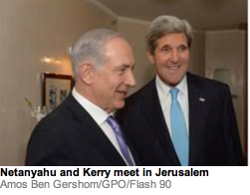
The United States intends to try and force a peace agreement on Israel and the Palestinian Authority (PA), IDF Radio reported Monday.
The radio station says the US has informed Israel and the Palestinian Authority that if negotiations between them do not advance, Washington will propose its own solution, that will include a US position on every point that is in contention. In effect, according to the report, this will be an attempt to force the sides to agree on a solution formulated by the US.
MK Zehava Galon (Meretz) was quoted as saying Monday that senior US officials told her the US offer would be presented in January of 2014. PA sources also cited January as the month in which the US intends to propose, or impose, its plan.
The US moves comes after three months of talks between the sides which have reportedly made very little headway.
The US plan reportedly is similar to the Clinton outline, offered by President Bill Clinton in late 2000, which is based on an Israeli retreat to 1949 Armistice lines, and some swaps of territory.
The Obama Administration is reportedly determined to achieve “a diplomatic breakthrough” by mid-2014, and believes that Israel under Binyamin Netanyahu and the PA under Mahmoud Abbas are capable of reaching agreement.
Until now, the talks were based on the idea that the two sides negotiate directly, with the US only acting as a mediator.
The American decision to present a proposed agreement was reportedly communicated by several senior officials, including the Special Representative to the talks, Martin Indyk. Secretary of State John Kerry reportedly briefed Netanyahu on the matter when they last met, in Italy.
IDF Radio is run by the Israeli military and partially staffed by soldiers but is considered to be a mainstream news outlet that is not substantially different from mainstream civilian outlets.
***
The Independent
Israel orders more demolitions of Palestinian flats in Jerusalem
Move to demoliish hundreds of Arab apartments ‘destroying every chance of peace’, says Fatah
BEN LYNFIELD
JERUSALEM
TUESDAY 05 NOVEMBER 2013

Israel is planning to destroy hundreds of Palestinian apartments in occupied East Jerusalem in the single largest proposed demolition there since it annexed the area after the 1967 war.
The proposed demolition of structures deemed illegal in the Ras Hamis area, adjoining Shuafat refugee camp, was announced in posters put up on apartment buildings last week.
Standing in front of the 11-storey building where he lives, which sits on a dusty, unpaved street with no pavement in Ras Hamis, Issam Mohammed Ali, a civil engineer, said that 44 families in the block stood to lose their homes. “People don’t have money for another home. If our home is destroyed we can only buy a tent,” said Mr Ali, who is married with two children.
A descendant of refugees from one of the villages destroyed during the 1948 Arab-Israeli War, Mr Ali said that if the demolition went ahead, it would not be the first time his family had lost its home to Israel. “We are ready to die for our home,” he added.
A friend of Mr Ali, who also stands to lose his flat, asked a reporter if the demolitions really would take place, adding: “Who will stop them? Obama? Cameron? Of course not. They do whatever they want.”
Daoud Sabha, who has been a maintenance worker at the Jerusalem Post for 19 years, said he had used all of his severance pay and gone into debt for four years to buy his flat in Ras Hamis. “This is racism against poor people who need their homes,” he said.
Israel says the homes are illegal and were built without permits. “The municipality has a clear policy against building illegally whether done by Arabs or Jews in every part of Jerusalem,” said Brachie Sprung, a spokeswoman for the local authority. She stressed that the demolition plans did not constitute a “new policy” and the timing of the orders was dictated by court rulings.
The demolition orders add to Israeli-Palestinian distrust that threatens to impinge on a visit by the US Secretary of State, John Kerry, who is due to meet separately with the Israeli Prime Minister, Benjamin Netanyahu, and the Palestinian President, Mahmoud Abbas, today in an attempt to encourage reconciliation between the two sides.
They have been engaged in what appear to have been fruitless negotiations since peace talks were revived in July. Israel also recently disclosed plans for thousands of new settler housing units to be built in East Jerusalem, where Palestinians hope to establish their capital, and in the West Bank.
“Israel is destroying every chance for peacemaking,” said Abdullah Abdullah, the deputy commissioner for international relations of Palestinian President Mahmoud Abbas’s Fatah movement. “The demolition orders are a slap in the face of Kerry and go against all his efforts to revive the peace process.”
Mark Regev, a spokesman for Mr Netanyahu, took issue with that assessment. “The Palestinian leadership is being disingenuous. This round of peace talks is based on understandings which Israel is keeping scrupulously. The Palestinians knew that settlement building would continue [during the negotiations],” he said.
Ms Sprung said the demolition orders were for 11 high-rise buildings, but Palestinians said a larger number had been issued. The blocks of flats lie beyond Israel’s West Bank separation barrier but within territory annexed to the Jerusalem municipality in after the Arab-Israeli war of 1967.
Yehudit Oppenheimer, the director of the peaceable Ir Amim group, said that in recent years the municipality had forced people to relocate to the new high-rises by severely restricting construction in other Arab areas of Jerusalem.
She said the demolition orders would be virtually impossible to implement “without causing a disaster” since they involved high-rises that are close to one another.
Instead, Ms Oppenheimer said, the orders were probably meant to “threaten” residents.
***
CNN
Report: Tests 'moderately support' that Arafat poisoned by polonium
By CNN Staff
November 6, 2013 -- Updated 2355 GMT (0755 HKT)
(CNN) -- Swiss scientists say levels of polonium-210 measured in the personal effects and body tissues of Palestinian leader Yasser Arafat "moderately" support a proposition that he died of polonium poisoning.
The findings released by the University Center of Legal Medicine of Lausanne -- first reported Wednesday by Al Jazeera -- do not address how Arafat, who died in 2004 at age 75, might have been poisoned or who might have done it.
The report comes a year after Arafat's widow, suspecting he was poisoned, had the body exhumed for tests after the radioactive isotope polonium-210 was found on some of his personal belongings in 2012.
The Swiss center said it identified "significant quantities" of polonium in biological stains on those belongings. Some polonium also was found in samples of remains taken during last year's exhumation, it said.
The scientists' findings may renew controversial allegations over how Arafat -- the most prominent face of Palestinian opposition to Israel for five decades -- died. The Palestinian Authority, which runs the West Bank, has said Israel would have been behind any poisoning of Arafat, who was regarded by many Palestinians as a father figure.
"I believe that all fingers are pointed at the Israeli occupation ... who have experience in such cases of poisoning," said Wasel Abu Yousef, a member of the executive committee of the Palestine Liberation Organization. Yousef called for a "criminal international committee" to be formed to investigate the report.
An Israeli Foreign Ministry spokesman said Wednesday that any such accusation would be "utter nonsense."
"This is nothing to do with us, and for the moment they refrained (from) making accusations," Israeli Foreign Ministry spokesman Yigal Palmor said. "They know why -- there's no strictly no connection to Israel."
***
Israel Hayom
Vatican, Israel reach historic deal on Last Supper site
Pope will have official seat in the Last Supper room on Mount Zion in Jerusalem • Deputy Foreign Minister Danny Ayalon: This is a historic achievement and a symbol that will encourage tourism.
Shlomo Cesana
November 5, 2013
Pope Benedict XVI and Benjamin Netanyahu greet each other in Tel Aviv, Israel, in 2009. [Archive] | Photo credit: AP
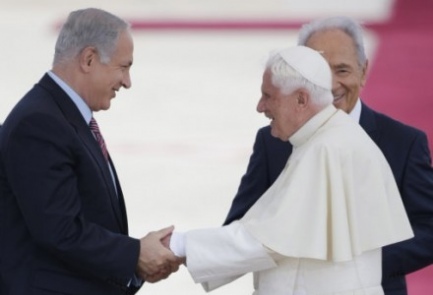
A historical agreement has been signed between Israel and the Vatican, ending a 20 year dispute. Israel has granted the pope an official seat in the room where the Last Supper is believed to have taken place, on Mount Zion in Jerusalem.
Israel did not give up its control over the room, as the Vatican had demanded, but Israel did decide to allow Vatican representatives a special modicum of control over the site.
An additional caveat of the agreement is a tax exemption that Israel will grant to all of the Vatican's institutions in Israel.
Deputy Foreign Minister Danny Ayalon and Monsignor Ettore Balestrero, Undersecretary of the Holy See for the Relations with States, sealed the deal on Tuesday. It will be signed in June at the Vatican.
On Tuesday, Ayalon said that this is a historic achievement and a symbol that will encourage tourism.
***
Activist Post
Usury: Weapon of Control and Enslavement – Part 1 of 2
Paul Adams, J.D.
Monday, November 4, 2013
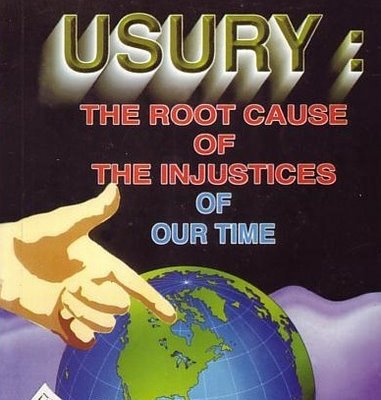
The world economy is based on the sand foundation of usury, which was considered a sin and tool of covert warfare for thousands of years.
The rich rules over the poor,
And the borrower is servant to the lender. Proverbs 22:7
Let me issue and control a nation's money and I care not who writes its laws -- Attributed to Mayer Amschel Rothschild
The world financial system seems complex but it is actually very simple: a cabal of bankers has conquered the world by lending people and governments money that does not exist and charging interest on it. No lasting economic recovery or increased standard of living is possible for the majority unless usury and the political power of bankers are abolished.
History
Usury is the lending of money with interest.
Historically, many cultures regarded the charging of interest for loans as sinful. Some of the earliest known condemnations of usury come from the Vedic texts of India. Similar condemnations are found in the religious texts from Buddhism, Judaism, Christianity, and Islam. At times, many nations from ancient China to ancient Greece to ancient Rome have outlawed loans with any interest. Though the Roman Empire eventually allowed loans with carefully restricted interest rates, the Christian church in medieval Europe banned the charging of interest at any rate.
Usury has been denounced by a number of religious leaders and philosophers in the ancient world, including Moses, Plato, Aristotle, Cato, Cicero, Seneca, Jesus, Aquinas, Martin Luther, Muhammad, Gautama Buddha.
The ancient Israelites called usury "a bite." It is like the slow poison of a serpent: "Usury does not all at once destroy a man or nation with, as it were, a bloody gulp. Rather, it slowly, sometimes nearly imperceptibly, subverts the victim's constitution until he cannot prevent the fatal consequences even though he knows what is coming."
The Old Testament "also classes the usurer with the shedder of blood, the defiler of his neighbor's wife, the oppressor of the poor, the spoiler by violence, the violator of the pledge, the idolater.”
Indeed, the only time the Prince of Peace became violent is when he cleansed the temple of the money changers.
… Jesus went up to Jerusalem. In the temple he found those who were selling oxen and sheep and pigeons, and the money-changers sitting there. And making a whip of cords, he drove them all out of the temple, with the sheep and oxen. And he poured out the coins of the money-changers and overturned their tables.
Modern churches and synagogues remain silent in the face of this great evil. And today, the money changers (high-level bankers) have conquered the world with usury as their discreet weaponry. It is the fraudulent foundation of nearly all economies through debt-based currencies issued by privately owned central banks, fractional reserve lending, mortgages, credit cards, auto loans, business loans, and IMF loans.
The most powerful money changers have established think-tanks with their ill-gotten gains, such as the Council on Foreign Relations, Trilateral Commission and Bilderberg Group, which control all major political parties (The Establishment).
To free the world of debt slavery and a totalitarian world government run by money changers, it is necessary to understand these frauds.
Fractional Reserve Usury Banking
Banking was conceived in iniquity and was born in sin. The Bankers own the earth. Take it away from them, but leave them the power to create deposits, and with the flick of the pen they will create enough deposits to buy it all back again. However, take it away from them, and all the great fortunes like mine disappear, and they ought to disappear, for this would be a happier and better world to live in. But, if you wish to remain the slaves of Bankers and pay the cost of your own slavery, let them continue to create deposits. -- Sir Josiah Stamp (President of the Bank of England in the 1920s).
Local and large banks profit tremendously from the fraud known as fractional reserve lending. While bankers wear suits and appear respectable, they actually prowl around like roaring lions seeking someone to devour. It works like this:
I set up a Rothbard Bank, and invest $1,000 of cash. Then I 'lend out' $10,000 to someone, either for consumer spending or to invest in his business. How can I 'lend out' far more than I have? Ahh, that's the magic of the 'fraction' in the fractional reserve. I simply open up a checking account of $10,000 which I am happy to lend to Mr. Jones. Why does Jones borrow from me? Well, for one thing, I can charge a lower rate of interest than savers would. I don't have to save up the money myself, but simply can counterfeit it out of thin air. Since demand deposits at the Rothbard Bank function as equivalent to cash, the nation's money supply has just, by magic, increased by $10,000. The inflationary, counterfeiting process is under way.
To simplify, the inequity of the world’s banking system is the fact that the money borrowed from a bank is created out of nothing. On the other hand, the borrower must actually produce real goods and services to earn money to pay back the loan plus interest.
When bankers create money faster than the economy grows, the purchasing power of the dollar declines which is known as inflation. The majority of the population is competing like wild animals during a famine to earn enough money to pay their debts and feed their families.
Home Mortgage Usury

A thirty-year-debt-slave is someone that has a home mortgage. First, the debtor is borrowing money that was created out of nothing through fractional reserve lending.
Second, after years of making payments, the debtor may become injured or unemployed. The bank will�then foreclose and sell the house. The bank will keep the proceeds of the sale and all the principal and interest that the borrower paid prior to going into default. Therefore, the borrower, who normally puts down only 20 percent (or much less) of the purchase price, bears almost 100% percent of the risk despite the fact that the bank decided to loan the other 80% (or more).
Third, the cost of a home loan is approximately double the amount borrowed when thirty years of interest payments are included. For example, if a borrower with good credit buys a $300,000 house and puts down 20 percent ($60,000), the borrower will borrow $240,000 from the bankers. The interest on a $240,000 loan at 5% (a historically low interest rate) over thirty years is $223,813.88. Therefore, the total cost of the $300,000 home is actually $463,813.88 (not including property taxes and insurance). Run the numbers yourself.
Credit Card Usury

Those who do not pay off their credit cards each month are slaves to usury. The average Annual Percentage Rate (APR) for a credit card in the United States is 14.95%. Credit cards with APRs above 20% are common.
In California, the Attorney General admits that limits on usury applicable to individuals making loans “do not apply to most lending institutions such as banks, credit unions, finance companies, pawn brokers, etc.”
Student Loan Usury
Approximately 40 million Americans have borrowed money to attend college. The average balance is close to $25,000. Nearly 50 percent of recent college graduates are unemployed or working in jobs that don’t require a college degree and pay accordingly. Students should know that in most cases student loans are not dischargeable in bankruptcy.
The Federal Reserve
In the United States, usury originates through the private Federal Reserve banking system. The Creature from Jekyll Island documents the following individuals drafted the Federal Reserve legislation in secret at Jekyll Island in 1910 (page 5 of the fourth edition):
Paul Warburg, a partner of international investing giant Kuhn, Loeb & Company, a representative of the Rothschild banking dynasty in Europe, brother to Max Warburg who was head of the Warburg banking consortium in Germany.
Senator Nelson Aldrich: business associate of J.P. Morgan and father-in-law to John D. Rockefeller, Jr.
Frank Vanderlip: president of National City Bank of New York, one of the most powerful banks at the time, representing William Rockefeller and Kuhn, Loeb & Company.
Henry Davidson: senior partner of J.P. Morgan.
Charles Norton: president of J.P. Morgan’s First National Bank of New York.
Abraham Andrew, Assistant Secretary of the U.S. Treasury.
Benjamin Strong, head of J.P. Morgan’s Bankers Trust Company.
Woodrow Wilson signed the Federal Reserve Act into law on December 23, 1913. On that day, the U.S. government officially transferred its power to create money and regulate the value thereof to the world’s wealthiest private bankers. Furthermore, the U.S. government would now borrow money from private banks, enslaving its citizens with the national debt, rather than creating its own money interest free.
Former Federal Reserve Chairman Alan Greenspan publicly brags that the private banking cartel is above the law and creates unlimited money out of nothing to loan its insolvent borrower, the U.S. government.
David Lang, a Federal Reserve employee, admits that the Federal Reserve is a private corporation that pays dividends to its undisclosed shareholders. The head of security at the San Antonio Federal Reserve also admits the institution is private.
So who receives dividends from owning shares of the private Federal Reserve? Charts created by the House Banking Committee Staff Report of August, 1976 reveal the following people and companies own shares in the Federal Reserve: Rothschilds, J.P. Morgan, the Warburgs banks, Lehman Brothers, Kuhn, Loeb & Company, Jacob Schiff, William Rockefeller, David Rockefeller/Chase Bank, and many others.
A more recent study found that Bank of America, JP Morgan Chase, Citigroup, Wells Fargo and HSBC now have the power of the Federal Reserve at their fingertips.
The IRS and Federal Reserve
Like the Federal Reserve, the IRS was created in 1913. The purpose of the IRS is to enslave citizens by stealing the value of their labor through collecting income taxes; by force if necessary.
Tax Freedom Day 2013 arrived on April 18 this year, meaning that Americans will work 108 days into the year, from January 1 to April 18, to earn enough money to pay this year’s combined 29.2% federal, state, and local tax bill.
In other words, on average, the IRS and other tax collectors steal over 3.5 months of each Americans’ labor time each year.
The private Federal Reserve is one of largest holders of U.S. government debt, owning approximately $1.794 trillion in U.S. Treasury securities. Much of the collected federal income taxes go towards paying interest on the national debt to the Fed for money that it created out of nothing and loaned to the government at interest. This unfortunate reality has been verified by G. Edward Griffin, Joe Plummer, IRS whistleblower, Joe Banister, and many others.
In part 2 of this article, we will examine crimes associated with usury and practical solutions.
Paul Adams is your humble servant and a follower of Jesus Christ.
(Woe to them that devise iniquity, and work evil upon their beds! when the morning is light, they practise it, because it is in the power of their hand. And they covet fields, and take them by violence; and houses, and take them away: so they oppress a man and his house, even a man and his heritage. Therefore thus saith the Lord; Behold, against this family do I devise an evil, from which ye shall not remove your necks; neither shall ye go haughtily: for this time is evil. Micah 2:1-3)
***
GlobalResearch
Ireland: Ground Zero for the Austerity-driven Asset Grab. The Bank Guarantee That Bankrupted Ireland
By Ellen Brown
November 02, 2013
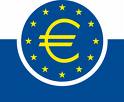
The Irish have a long history of being tyrannized, exploited, and oppressed—from the forced conversion to Christianity in the Dark Ages, to slave trading of the natives in the 15th and 16th centuries, to the mid-nineteenth century “potato famine” that was really a holocaust. The British got Ireland’s food exports, while at least one million Irish died from starvation and related diseases, and another million or more emigrated.
Today, Ireland is under a different sort of tyranny, one imposed by the banks and the troika—the EU, ECB and IMF. The oppressors have demanded austerity and more austerity, forcing the public to pick up the tab for bills incurred by profligate private bankers.
The official unemployment rate is 13.5%—up from 5% in 2006—and this figure does not take into account the mass emigration of Ireland’s young people in search of better opportunities abroad. Job loss and a flood of foreclosures are leading to suicides. A raft of new taxes and charges has been sold as necessary to reduce the deficit, but they are simply a backdoor bailout of the banks.
At first, the Irish accepted the media explanation: these draconian measures were necessary to “balance the budget” and were in their best interests. But after five years of belt-tightening in which unemployment and living conditions have not improved, the people are slowly waking up. They are realizing that their assets are being grabbed simply to pay for the mistakes of the financial sector.
Five years of austerity has not restored confidence in Ireland’s banks. In fact the banks themselves are packing up and leaving. On October 31st, RTE.ie reported that Danske Bank Ireland was closing its personal and business banking, only days after ACCBank announced it was handing back its banking license; and Ulster Bank’s future in Ireland remains unclear.
The field is ripe for some publicly-owned banks. Banks that have a mandate to serve the people, return the profits to the people, and refrain from speculating. Banks guaranteed by the state because they are the state, without resort to bailouts or bail-ins. Banks that aren’t going anywhere, because they are locally owned by the people themselves.
Ireland was the first European country to watch its entire banking system fail. Unlike the Icelanders, who refused to bail out their bankrupt banks, in September 2008 the Irish government gave a blanket guarantee to all Irish banks, covering all their loans, deposits, bonds and other liabilities.
At the time, no one was aware of the huge scale of the banks’ liabilities, or just how far the Irish property market would fall.
Within two years, the state bank guarantee had bankrupted Ireland. The international money markets would no longer lend to the Irish government.
Before the bailout, the Irish budget was in surplus. By 2011, its deficit was 32% of the country’s GDP, the highest by far in the Eurozone. At that rate, bank losses would take every penny of Irish taxes for at least the next three years.
“This debt would probably be manageable,” wrote Morgan Kelly, Professor of Economics at University College Dublin, “had the Irish government not casually committed itself to absorb all the gambling losses of its banking system.”
To avoid collapse, the government had to sign up for an €85 billion bailout from the EU-IMF and enter a four year program of economic austerity, monitored every three months by an EU/IMF team sent to Dublin.
Public assets have also been put on the auction block. Assets currently under consideration include parts of Ireland’s power and gas companies and its 25% stake in the airline Aer Lingus.
At one time, Ireland could have followed the lead of Iceland and refused to bail out its bondholders or to bow to the demands for austerity. But that was before the Irish government used ECB money to pay off the foreign bondholders of Irish banks. Now its debt is to the troika, and the troika are tightening the screws. In September 2013, they demanded another 3.1 billion euro reduction in spending.
Some ministers, however, are resisting such cuts, which they say are politically undeliverable.
In The Irish Times on October 31, 2013, a former IMF official warned that the austerity imposed on Ireland is self-defeating. Ashoka Mody, former IMF chief of mission to Ireland, said it had become “orthodoxy that the only way to establish market credibility” was to pursue austerity policies. But five years of crisis and two recent years of no growth needed “deep thinking” on whether this was the right course of action. He said there was “not one single historical instance” where austerity policies have led to an exit from a heavy debt burden.
Austerity has not fixed Ireland’s debt problems. Belying the rosy picture painted by the media, in September 2013 Antonio Garcia Pascual, chief euro-zone economist at Barclays Investment Bank, warned that Ireland may soon need a second bailout.
According to John Spain, writing in Irish Central in September 2013:
The anger among ordinary Irish people about all this has been immense. . . . There has been great pressure here for answers. . . . Why is the ordinary Irish taxpayer left carrying the can for all the debts piled up by banks, developers and speculators? How come no one has been jailed for what happened?. . . [D]espite all the public anger, there has been no public inquiry into the disaster.
Bail-in by Super-tax or Economic Sovereignty?
In many ways, Ireland is ground zero for the austerity-driven asset grab now sweeping the world. All Eurozone countries are mired in debt. The problem is systemic.
In October 2013, an IMF report discussed balancing the books of the Eurozone governments through a super-tax of 10% on all households in the Eurozone with positive net wealth. That would mean the confiscation of 10% of private savings to feed the insatiable banking casino.
The authors said the proposal was only theoretical, but that it appeared to be “an efficient solution” for the debt problem. For a group of 15 European countries, the measure would bring the debt ratio to “acceptable” levels, i.e. comparable to levels before the 2008 crisis.
A review posted on Gold Silver Worlds observed:
[T]he report right away debunks the myth that politicians and main stream media try to sell, i.e. the crisis is contained and the positive economic outlook for 2014.
. . . Prepare yourself, the reality is that more bail-ins, confiscation and financial repression is coming, contrary to what the good news propaganda tries to tell.
A more sustainable solution was proposed by Dr Fadhel Kaboub, Assistant Professor of Economics at Denison University in Ohio. In a letter posted in The Financial Times titled “What the Eurozone Needs Is Functional Finance,” he wrote:
The eurozone’s obsession with “sound finance” is the root cause of today’s sovereign debt crisis. Austerity measures are not only incapable of solving the sovereign debt problem, but also a major obstacle to increasing aggregate demand in the eurozone. The Maastricht treaty’s “no bail-out, no exit, no default” clauses essentially amount to a joint economic suicide pact for the eurozone countries.
. . . Unfortunately, the likelihood of a swift political solution to amend the EU treaty is highly improbable. Therefore, the most likely and least painful scenario for [the insolvent countries] is an exit from the eurozone combined with partial default and devaluation of a new national currency. . . .
The takeaway lesson is that financial sovereignty and adequate policy co-ordination between fiscal and monetary authorities are the prerequisites for economic prosperity.
Standing Up to Goliath
Ireland could fix its budget problems by leaving the Eurozone, repudiating its blanket bank guarantee as “odious” (obtained by fraud and under duress), and issuing its own national currency. The currency could then be used to fund infrastructure and restore social services, putting the Irish back to work.
Short of leaving the Eurozone, Ireland could reduce its interest burden and expand local credit by forming publicly-owned banks, on the model of the Bank of North Dakota. The newly-formed Public Banking Forum of Ireland is pursuing that option. In Wales, which has also been exploited for its coal, mobilizing for a public bank is being organized by the Arian Cymru ‘BERW’ (Banking and Economic Regeneration Wales).
Irish writer Barry Fitzgerald, author of Building Cities of Gold, casts the challenge to his homeland in archetypal terms:
The Irish are mobilising and they are awakening. They hold the DNA memory of vastly ancient times, when all men and women obeyed the Golden rule of honouring themselves, one another and the planet. They recognize the value of this harmony as it relates to banking. They instantly intuit that public banking free from the soiled hands of usurious debt tyranny is part of the natural order.
In many ways they could lead the way in this unfolding, as their small country is so easily traversed to mobilise local communities. They possess vast potential renewable energy generation and indeed could easily use a combination of public banking and bond issuance backed by the people to gain energy independence in a very short time.
When the indomitable Irish spirit is awakened, organized and mobilized, the country could become the poster child not for austerity, but for economic prosperity through financial sovereignty.
Ellen Brown is an attorney, president of the Public Banking Institute, and author of twelve books, including the best-selling Web of Debt. In The Public Bank Solution, her latest book, she explores successful public banking models historically and globally. Her blog articles are at EllenBrown.com.
***
BEFORE IT'S NEWS
On the brink of WW3 : Powerful Russian Ships Establish Largest Russian Presence Ever In Mediterranean
on November 6, 2013
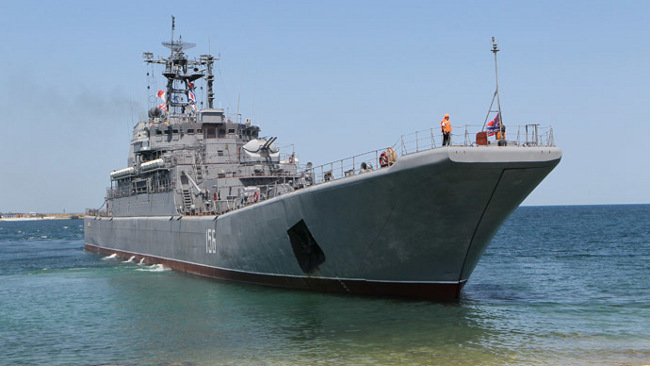
Powerful Russian Ships Establish Largest Russian Presence Ever In Mediterranean
Moscow’s request for a naval base in Egypt submitted last week by a visiting Russian general prompted US Secretary of State John Kerry’s decision to hurry up and visit Cairo and Riyadh for an attempt to smooth their prickly relations over Washington’s policies for Syria and Iran. However, Sunday, Nov. 3, the day he stopped over in Cairo en route for Riyadh, saw a mighty buildup of Russian naval stgrength in the Mediterranean.
Russia’s Pacific Fleet flagship, the Varyag,and the powerful nuclear-fueled battleship Pyotr Veliky arrived to carry out “a number of tasks” with other Russian Navy ships in the region, according to the official statement form Moscow.
debkafile’s military sources report that the two new arrivals expand Russia’s Mediterranean naval presence to 16 vessels. Among them are the missile cruiser Moskva and three of Russian navy’s largest amphibian craft, the Aleksandr Shabalin, the Novocherkassk and the Minsk, all carrying large detachments of marines, and a fourth landing craft, the Azov, there since last month.
The Russian fleet has moved into the vacuum left by the withdrawal of US warships which followed President Barack Obama’s decision not to attack Syria’s chemical weapons. It has established the largest Russian presence ever in the Mediterranean with the strongest firepower of any other force in the eastern and central stretches of this water. Russian warships are now present opposite Cyprus, Syria, Lebanon, Israel, Egypt, the Suez Canal and Libya.
Moscow’s request for a naval base to serve this fleet hovered in the background of John Kerry’s conversation with Saudi King Abdullah and Foreign Minister Saud al-Faisal Monday, Nov 4. His departure from Cairo was dogged by rumors of an impending visit to Egypt by President Vladimir Putin.
As debkafile reported earlier, Saudi Arabia engineered the Russian-Egyptian rapprochement with a view to bringing Russian military advisers back to Egypt for the first time since they were thrown out in 1972. Moscow was designated as major arms supplier to the Egyptian army in lieu of Washington.
debkafile’s wouds reveal the four locations Moscow has chosen for port facilities to accommodate its war fleet:
— Alexandria. A dock or berth in the big port of Alexandria and the use of a group of port warehouses to be developed into naval facilities of the sort Russia built in the Syrian port of Tartus. Moscow did not indicate plans to quit Tartus, but the urgency of its request to Cairo suggested its desire for an alternative Mediterranean base in case it had to leave Syria in haste. In any case, Tartus has only been partly operational in recent months.
— Damietta. This port is located on the western tributary of the Nile, 15 km from the Mediterranean Sea and 70 km from Port Said.
— Port Said at the northern terminus of the Suez Canal.
— Rosetta (Rasid) in the Nile Delta, 65 km east of Alexandria.
Our military sources say that a naval base at any of these ports will give Russia a foothold on a central Mediterranean shore and make it the only superpower with a naval and military presence in control of the vastly important Suez Canal to world shipping and trade and the principle marine link connecting US naval and military forces in the Mediterranean and Persian Gulf.
That no joint communiqués were issued before Kerry departed Cairo and Riyadh illustrated the intractability of their feud with Washington.
The US Secretary spoke on his own behalf to US embassy staff in the Saudi capital.
Washington’s relationship with the Saudis was crucial, as the region faced changes and challenges from the transition in Egypt to the civil war in Syria, he said and went on to stress: “The Saudis are very, very important to all of us.
The Saudis are really the senior player in the Arab world together with Egypt.” Observers noted that Kerry did not touch on any understandings reached with the Egyptian and Saudi governments in his two days of talks with their leaders.
His visit to Egypt was the first by a senior US official since Mohamed Morsi was deposed as president in July, and the first to Saudi Arabia since intelligence chief Prince Bandar bin Sultan warned last month of a “shift away” from Washington and announced Saudi abdication of its seat on the UN Security Council.
After Riyadh, the Secretary of State continues his Middle East tour, arriving Tuesday night in Jerusalem and meeting Palestinian leaders in Bethlehem Wednesday. He will also make stops in Jordan, the United Arab Emirates, Algeria and Morocco.
***
The Washington Times
Inside China: Nuclear submarines capable of widespread attack on U.S.
By Miles Yu
Thursday, October 31, 2013
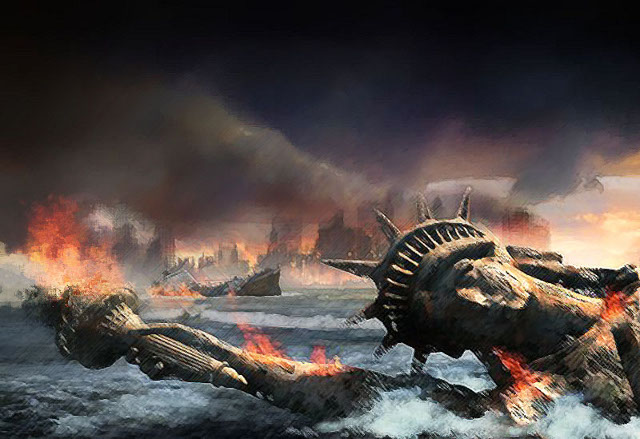
Chinese state-run media revealed for the first time this week that Beijing’s nuclear submarines can attack American cities as a means to counterbalance U.S. nuclear deterrence in the Pacific.
On Monday, leading media outlets including China Central TV, the People’s Daily, the Global Times, the PLA Daily, the China Youth Daily and the Guangmin Daily ran identical, top-headlined reports about the “awesomeness” of the People's Liberation Army navy’s strategic submarine force.
“This is the first time in 42 years since the establishment of our navy’s strategic submarine force that we reveal on such a large scale the secrets of our first-generation underwater nuclear force,” the Global Times said in a lengthy article titled “China for the First Time Possesses Effective Underwater Nuclear Deterrence against the United States.”
The article features 30 photos and graphics detailing, among other things, damage projections for Seattle and Los Angeles after being hit by Chinese nuclear warheads and the deadly radiation that would spread all the way to Chicago.
China’s sub fleet is reportedly the world’s second-largest, with about 70 vessels. About 10 are nuclear-powered, and four or more of those are nuclear ballistic submarines capable of launching missiles.
Heavily influenced by Soviet naval models that stressed underwater forces, China’s nuclear submarine development began with the reverse-engineering of a Soviet Golf-class conventional-powered sub in the 1950s.
In the 1980s, China developed its first ballistic missile sub, the Type 092 Xia-class, which has 12 launch tubes for the Julang (Giant Wave)-1 missiles. The JL-1 had a limited range and failed multiple test launches.
In 2010, a new class of missile sub, the Type 094 Jin class, entered the service. It is capable of launching 12 to 16 JL-2 missiles with a range of about 8,700 miles, covering much of the continental U.S. with single or multiple, independently targetable re-entry vehicle warheads.
Chinese calculations for nuclear attacks on the U.S. are chillingly macabre.
“Because the Midwest states of the U.S. are sparsely populated, in order to increase the lethality, [our] nuclear attacks should mainly target the key cities on the West Coast of the United States, such as Seattle, Los Angeles, San Francisco and San Diego,” the Global Times said.
“The 12 JL-2 nuclear warheads carried by one single Type 094 SSBN can kill and wound 5 million to 12 million Americans,” the Global Times reported.
China also has developed land-based intercontinental ballistic missiles — notably the DF-31A, which has a range of 7,000 to 7,500 miles.
“If we launch our DF 31A ICBMs over the North Pole, we can easily destroy a whole list of metropolises on the East Coast and the New England region of the U.S., including Annapolis, Philadelphia, New York, Boston, Portland, Baltimore and Norfolk, whose population accounts for about one-eighth of America’s total residents,” the Global Times said.
All the state-run press reports stressed the point that the PLA’s missile submarines are now on routine strategic patrol, “which means that China for the first time has acquired the strategic deterrence and second strike capability against the United States.”
“Our JL-2 SLBMs have become the fourth type of Chinese nuclear missiles that threaten the continental United States, after our DF-31A, DF-5A and DF-5B ICBMs,” said the Global Times.
***
The Times Of Israel
Saudi Arabia said to have bought nukes from Pakistan
Warheads stand ready for delivery if and when Iran goes nuclear, report says; Riyadh has the missiles needed to launch them
BY STUART WINER November 7, 2013
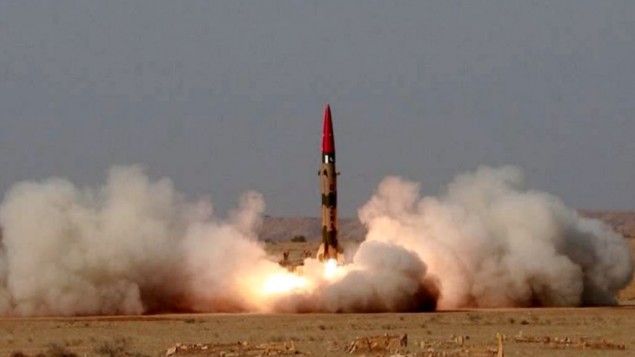
Test launch of a Pakistan-made Shaheen ballistic missile (screen capture: Youtube/Al Jazeera English)
Saudi Arabia may be prepared to field nuclear bombs it has purchased from Pakistan in response to Iran’s alleged military nuclear program, and may already have deployed missile systems capable of delivering the bombs, the BBC reported on Wednesday.
According to Mark Urban, diplomatic and defense editor for the BBC’s Newsnight, there are suggestions that the Saudis have paid for a number of nuclear weapons that are ready and waiting in Pakistan. If the reports are accurate, the kingdom could have atomic weapons on its missiles even before Iran has that capability.
Urban said it was an assessment shared by the former head of the IDF’s head of intelligence, Amos Yadlin, and cited comments Yadlin made to that effect at a conference in Sweden last month.
“The Saudis will not wait one month,” Yadlin reportedly said. “They already paid for the bomb, they will go to Pakistan and bring what they need to bring.”
Another source, described as “a senior NATO decision maker,” told Urban earlier this year of an intelligence report about Pakistani-made nuclear weapons ready for delivery to the kingdom.
Since 2009 Saudi Arabia has been sending clear warnings to the US that it will not sit back and let Iran go nuclear.
“I do think that the Saudis believe that they have some understanding with Pakistan that, in extremis,” they would be able to get nuclear weapons from Pakistan, Gary Samore, who until May this year was US President Barack Obama’s counter-proliferation adviser, was quoted as saying.
The Saudis already have the means to deliver nuclear weapons after acquiring Chinese-made CSS-2 missiles during the 1980s. The missiles, which have a range of over 2,500 kilometers, can be armed with nuclear warheads. In addition, it has been clear for many years that Saudi Arabia was funding the Pakistani defense establishment, the report said.
“What did we think the Saudis were giving us all that money for?” a senior Pakistan official was quoted as saying. “It wasn’t charity.”
The report did not say whether the warheads would simply be handed over to the Saudis, or if Pakistani military units would be deployed in the kingdom to oversee their use, although it suggested that Pakistani-made Shaheen (Falcon) ballistic missiles were already stationed in Saudia Arabia, minus their warheads.
In an email to the BBC, Yadlin left no doubt as to his take on the gravity of the prospect of a nuclear-armed Saudi Arabia.
“Unlike other potential regional threats, the Saudi one is very credible and imminent,” he wrote.
Officially, both Pakistan and Saudi Arabia denied the reports. The Pakistani Foreign Ministry told the BBC in a statement that the report of nuclear bombs ready and waiting was “speculative, mischievous and baseless.”
“Pakistan is a responsible nuclear weapon state with robust command and control structures and comprehensive export controls,” the statement said.
The Saudi Arabian embassy in London similarly rejected the suggestion and noted that the kingdom was signatory to the Nuclear Non-Proliferation Treaty. The embassy added that Saudi Arabia had rejected an offer to take a seat on the United Nations Security Council due, among other reasons, to the failure to keep the Middle East free of nuclear weapons.
***
The Independent
Poppycock – or why remembrance rituals make me see red
The poppy helps us avoid a search for the meaning of war
ROBERT FISK
Thursday 7 November 2013

On the briefest of visits to London, I was appalled to notice that our television presenters and politicians and dignitaries have almost all resorted to stereotype by wearing those bloody poppies again – even though I suspect most of them would not know the difference between the Dardanelles and the Somme. How come this obscene fashion appendage – inspired by a pro-war poem, for God’s sake, which demands yet further human sacrifice – still adorns the jackets and blouses of the Great and the Good? Even Tony Blair dares to wear a poppy – he who lied us into a war, which killed more people than the Battle of Mons.
I know all the reasons they give us. We must remember our dead. “They” died for us and our freedom. The cost of sacrifice. Remember Passchendaele. Never forget. At school I used to wear a poppy – without the leaf which now prettifies this wretched flower – and so did my Dad who, as I often recall, was a soldier of that Great War, in the trenches of the Third Battle of the Somme, 1918, and at Cambrai. But then, as 2nd Lieutenant Bill Fisk grew older and became sick, he read the biographies of that most meretricious of officers, Earl Haig – butcher Haig of the Somme, whose wife gave her name to the original poppies – and came to regard the wearing of these sickly and fake petals as hypocrisy. He stopped wearing the poppy for 11 November, and so did I.
At Ypres four years ago, I was honoured to give the Armistice Day lecture just before 11 November; but I did not wear a poppy and politely declined to lay a wreath at the Menin Gate – that “sepulchre of crime” as Sassoon called it – and I discovered, as the clergy purred away beneath the names of the 54,896 Great War soldiers with no known grave, a headstone atop the city’s old medieval wall. Nothing could equal the words which his family had courageously inscribed above the final resting place of 2nd Lieutenant Arthur Conway Young, who died on 16 August, 1917: “Sacrifice to the fallacy that war can end.”
So is there not some better way to remember this monstrous crime against humanity? The pity of war, as Wilfred Owen described it, must, for individuals, have a finite end, a point when time – looking backwards – just runs out. British men and women – and children – who visit the Somme battlefields and their vast cemeteries, still cry, and I can understand why. Here lies indeed the flower of youth cut short, only just over a generation distant. But we do not cry when we visit Waterloo or Agincourt. At Flanders Fields, the tears still flow. But not at Flodden Field. Who even weeps for the dead of the Boer War? No poppies for them. Only when you move into religious ecstasy can the long dead touch our souls. Watch the Christians walking the Way of the Cross in Jerusalem, or the Iraqi Shia remembering in the oven-like heat of Najaf and Kerballa the martyrdom of Imams Ali and Hussain. The tears splash down their clothes.
Perhaps in war, it’s the names that count. Dead soldiers had no gravestones before the Great War, unless they were generals, admirals or emperors worthy of entombment in Saint Paul’s or Les Invalides. The soldiery were simply dumped into mass graves. At Waterloo, the remains of the dead were shipped off to England to be used as manure on the fields of Lincolnshire – sometimes tilled, no doubt, by their unsuspecting farmer sons. So much for our remembrance of the “thin red line”. No posthumous glory for them.
Yet glory, I fear, does lie somewhere in our souls when we decide to bless our clothes with this preposterous poppy, this little paper and plastic “blood-drop” on our breasts, fake flowers that supposedly spring from the blood-red soil of the Flanders dead. It is perhaps easier to believe that the names will “live for evermore” – as it says on the walls of cemeteries of both Great Wars of the 20th century – even though hundreds of thousands of First World War Brits and French and Germans and Austrians and Irishmen in British uniform and Hungarians and Indians and Russians and Americans and Turks and, yes, even Portuguese (at Ypres) have no graves at all. But the poppy also helps us avoid a search for the meaning of war.
Wyndam Lewis, the master of Vorticist art who became a soldier at Ypres, wrote of the Great War that it “went on far too long… It was too vast for its meaning, like a giant with the brain of a midge. Its epic proportions were grotesquely out of scale, seeing what it was fought to settle. It was far too indecisive. It settled nothing, as it meant nothing. Indeed, it was impossible to escape the feeling that it was not meant to settle anything – that could have any meaning, or be of any advantage, to the general run of men.”
Tolstoy caught the other side of this “non-meaning” of war in his critique of Napoleon’s invasion of Russia. An “event took place”, he wrote in War and Peace, “opposed to human reason and human nature. Millions of men perpetrated against one another such innumerable crimes, frauds, treacheries, incendiarisms and murders, as in whole centuries are not recorded in the annals of all the law courts of the world, but which those who committed them did not at the time regard as being crimes.”
It was Lewis’s idea – that war was ultimately devoid of meaning – which my father was, I think, trying to capture when he described the 1914-18 conflict to me in his hospital room as “just one great waste”. He had survived that war and outlived another and the end of the British Empire, which I suspect we have not ceased mourning – could that be really what the poppies are all about? – and even lived long enough to watch the first Gulf War on television. He often quoted what he believed to be the last words of Nurse Edith Cavell, shot in Brussels by the Germans for rescuing Allied soldiers behind enemy lines, words which are inscribed on her monument beside the National Gallery: “Patriotism is not enough.” But in full, her very last words – spoken to a British chaplain before she was executed – were these: “But this I would say, standing in view of God and eternity, I realise that patriotism is not enough. I must have no hatred or bitterness towards anyone.” Read her words; and cast poppies aside.
For they are better, surely, than that terrible, almost orgiastic poem by the Toronto doctor John McCrae who died in 1915, and whose words inspired the armies of poppy-wearers. “In Flanders fields, the poppies blow/ Between the crosses, row on row...” McCrae begins – but then his dead soldiers exhort the living to “Take up our quarrel with the foe…/ If ye break faith with us who die/ We shall not sleep, though poppies grow/ In Flanders Fields.” The poppies were there to remind us of our duty to kill more human beings.
And what did I see on television a few hours before writing these words? Why, the mayor of Toronto – McCrea’s own city – admitting to the smoking of crack cocaine. “I sincerely, sincerely, sincerely apologise,” he burbled to us all. And what did I see in his jacket button hole? A bloody poppy! How they must have cried at Passchendaele…
***
RT
Why Vladimir rules and Obama bombs
Pepe Escobar is the roving correspondent for Asia Times/Hong Kong, an analyst for RT and TomDispatch, and a frequent contributor to websites and radio shows ranging from the US to East Asia.
Published time: November 01, 2013
On both the NSA saga and the Syrian crisis, Putin played chess while Obama played checkers with himself – and lost.
Every year, Forbes magazine publishes its list of the heads of state, financial titans and business moguls who “truly rule the world.” Predictably, a sitting US president – the commander-in-chief of the most lethal armada in the history of the world – usually gets the top spot.
Not in 2010 though, when Barack Obama was overtaken by then Chinese President Hu Jintao in the aftermath of the Wall Street-provoked financial crisis. And not in 2013, when the winner is Russian President Vladimir Putin.
Not by accident, China and Russia are the most influential among the BRICS group of emerging powers. The US corporate media’s rankings such as Time’s Person of The Year may be irrelevant, and usually extremely provincial. But as a PR coup, American recognition of Putin’s soft power is priceless, even coming after de facto recognition by the overwhelming majority of the real ‘international community’: the developing world.
To its credit, Forbes stresses how “anyone watching this year's chess match over Syria and the National Security Agency leaks has a clear idea of the shifting individual power dynamics."
But it goes way, way beyond that. Putin let the extremely sensitive Edward Snowden case be handled with total, absolute legality and transparency, and on top of it without gloating over American impotence. Putin literally saved the Obama administration, at the last minute, from yet another Middle-East war of potentially devastating consequences – a geopolitical juncture as dangerous as the Cuban missile crisis.
Predictably, US Think Tankland – with its collective IQ atrophied by decades of hubris and the normalization of the Orwellian/Panopticon complex – has had a hard time facing the facts. Moscow does not need to try to portray the hyperpower as weak and/or untrustworthy. The facts speak for themselves – from the galloping towards war because of a fictitious ‘red line’ recklessly concocted by Obama to the ubiquitous spying on ‘friends’ and potential foes alike.
During a House Intelligence Committee hearing, National Intelligence Director James Clapper was adamant that the NSA and the CIA cannot spy on any political leader via his/her private mobile phones without permission from the White House. So no matter the spin, Obama knew, among others, about the spying on Brazilian President Dilma Rouseff and German Chancellor Angel Merkel.
You don’t need to have read Orwell to note this is yet another instance of the imperial Masters of the Universe worldview. It’s ‘legitimate’ to spy on Americans. It’s ‘legitimate’ to spy all over the global South – including the more influential BRICS.
Call it electronic neo-feudalism – where no one, anywhere is a real citizen fully capable of exercising his/her rights; just some sort of un-glorified peasant. With Merkel the story is slightly different; she’s part of the Masters of the Universe club, and that’s the only reason why some in Washington are wondering if – in a very mild way – the NSA may have gone too far.
Enough exceptionalism
That famous September op-ed in The New York Times, in which Putin blasted American exceptionalism, reverberated wildly all across the developing world because it worked like a primal scream. The Chinese, naturally cautious, would never be the first to articulate it so blatantly (they did it only later, when they called for a ‘de-Americanized’ world, with an economic emphasis rather than political). Forget about the Europeans, or even Brazil. Only Putin had the authority to announce what the overwhelming majority of the planet had been thinking for quite a while.
Nobody can stand US exceptionalism anymore. Yet another example; the duly spied-upon UN General Assembly has voted - overwhelmingly - to condemn the US commercial, economic and financial embargo against Cuba for the 22nd year in a row. The vote was 188-2, with three abstentions. Only the US and Israel voted against it.
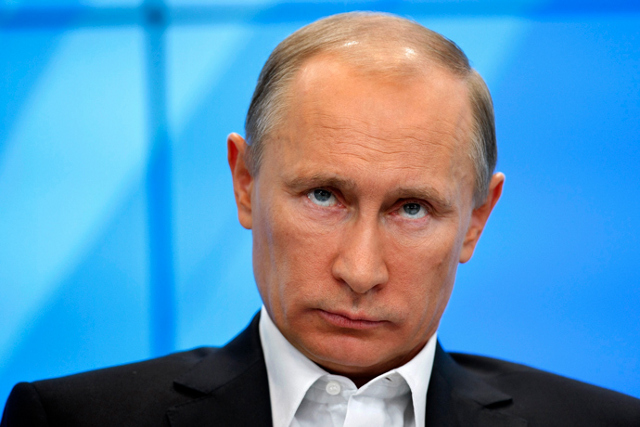
Vladimir Putin (Reuters / Alexander Zemlianichenko / Pool)
While the dogs of war and surveillance bark, the silent Russian caravan passes. Putin is extending Russian influence in Central Europe as well as solidifying the partnership with Germany. The Chinese-Russian strategic partnership is proceeding smoothly. Russia is back as an influential player in the Middle East. Putin is trying to create a viable, multilateral alternative to imperial US diktats. This is as much about soft power as hard power.
The proverbial US Think Tankland Cassandras will be left endlessly carping about the ‘stagnating’ Russian economy, ethnic and religious ‘tension’, ‘political atrophy’ because of Putin’s ‘authoritarianism’, and assorted ills. Nonsense. This essay by top blogger The Saker meticulously outlines the key plot twists and undercurrents of the past 20 years of US-Russia relations – including the now-proverbial Putin demonization.
Back to the facts on the geopolitical ground. Putin has seized the moment and now is arguably the key actor trying to build an emerging, alternative multilateral order. As for imperial lame duck Obama, he seems destined to keep bombing in more ways than one.
***
Ancient Origins
Have explorers in Ecuador found ‘Lost City of Giants'?
JOHNBLACK
25 OCTOBER, 2013
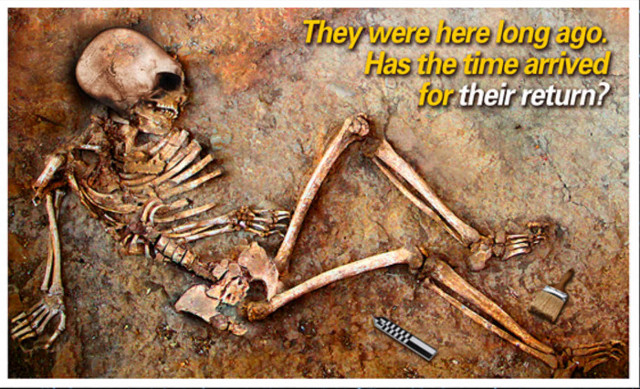
Last year, a team of explorers and researchers discovered what they believed to be an ancient pyramid complex in a remote area of the Ecuador Amazonian jungle, one not known to the general public internationally or even within the country. Bruce Fenton, author and researcher, has completed an analysis of the findings, and believes the complex may be the ‘Lost City of the Giants’.
At the discovered site there is one extremely large pyramidal type structure of approximately 80 metres square base and 80 metres height, with steeply inclined walls. This structure is made up of irregular shaped large cut stone blocks, each currently calculated to be approximately 2 tonnes in weight; many hundreds of such blocks make up the walls of the building.
The top appears to be a flat area suspected to have been a platform used by priests in either ceremonies or possibly sacrifices. Scattered around the area are a great many artefacts of stone and pottery. Many of these objects appear to be stone tools that could have been used either in mining or refining some kind of metal ore. The style of the buildings and the objects found all suggest an unknown pre-Inca culture. However, further investigation is needed to establish the facts, which Fenton and a team plan to conduct in the near future.
Amongst these tools are some that would be extremely difficult for a normal size human being to use in any practical fashion, which has led Fenton to suspect that this is one of the legendary lost cities of the giants, well known in local Ecuadorian legends about the Amazonian area. Such places generate great fear among the members of today’s jungle tribes as they are believed to be protected either by spirit guardians or by beings not of this world.
Local legends pertain to giant humans who lived in cities that have become forgotten in the pages of history. In fact bones of giant people have been found in caves in the area – as well as in other parts of Ecuador. This particular region was said to be a great meeting place of the tribes, in fact tribes from as far away as Brazil travelled to this location due to beliefs about its long standing importance and strong energetic vibration.
The team has so far identified several large hills near to the validated pyramid structure, each of them equal size to the supposed pyramid. It is possible that each of these hills is a pyramid yet to be uncovered. This would make for a very significant sized city and pyramid complex.
An international team of experts of ancient megalithic sites and pyramid technologies are planning further expeditions to the site to place it accurately on a map and to produce a one hour documentary to record the amazing features of this intriguing site.
(There were giants in the earth in those days; and also after that, when the sons of God came in unto the daughters of men, and they bare children to them, the same became mighty men which were of old, men of renown. Genesis 6:4)
***
MailOnline
Island of debris the size of TEXAS from 2011 Japanese tsunami is headed straight for the U.S.
Part of the over one million tons of debris dispersed in the Pacific, the trash island is located northeast of the Hawaiian Islands
By DAILY MAIL REPORTER
PUBLISHED: 22:41 EST, 4 November 2013 | UPDATED: 05:32 EST, 5 November 2013
A floating island of debris the size of Texas has been crossing the vast Pacific Ocean to the western shores of the Americas since a devastating tsunami inundated Japan in 2011, says a new study.
Five million tons of wreckage - the remains of homes, boats, and other remnants of shattered lives in eastern Japan - were swallowed by the ocean that day in March, and more than one million tons of flotsam continues to head towards the west coast of the US.
While the first documented debris from the tragedy has already been found in California, scientists fear these new findings mean there could be a lot more to come and it might arrive all at once.
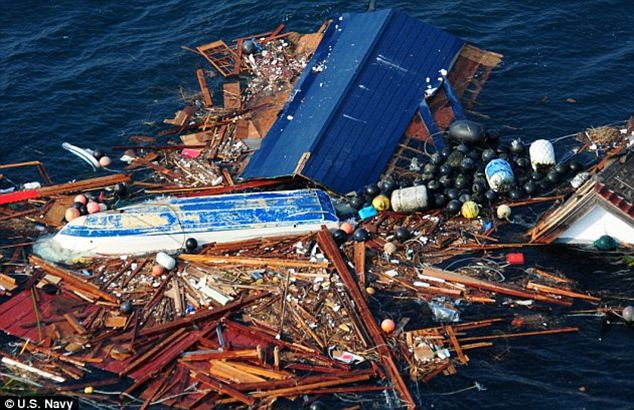
Gigantic: A floating island of debris the size of Texas is floating toward California coast after washing into the Pacific in Japan's horrific 2011 tsunami
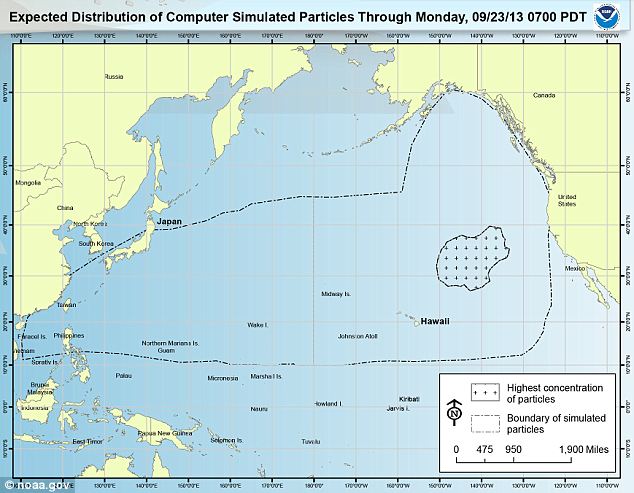
Slowly but surely: The Texas-sized trash island is floating to the northeast of Hawaii after over two years of sailing across the Pacific
The National Oceanic and Atmospheric Association (NOAA) released its updated findings last week, which show the huge island floating northeast of the Hawaiian Islands.
NOAA scientists add that a larger and less-concentrated debris field stretches from Alaska to the Philippines.
***
CNBC
The student loan bubble is starting to burst
Published: Thursday, 5 Sep 2013 | 2:06 PM ET
By: John Carney | Senior Editor, CNBC.com

The largest bank in the United States will stop making student loans in a few weeks.
JPMorgan Chase has sent a memorandum to colleges notifying them that the bank will stop making new student loans in October, according to Reuters.
The official reason is quite bland.
"We just don't see this as a market that we can significantly grow," Thasunda Duckett tells Reuters. Duckett is the chief executive for auto and student loans at Chase, which means she's basically delivering the news that a large part of her business is getting closed down.
The move is eerily reminiscent of the subprime shutdown that happened in 2007. Each time a bank shuttered its subprime unit, the news was presented in much the same way that JPMorgan is spinning the end of its student lending.
JPMorgan will not be accepting new private student loan applications, reports CNBC's Kayla Tausche. The decision applies to borrowers for next year.
"It's no longer sustainable and not the right place to allocate capital in the future," HSBC Holdings Group Chief Executive Michael Geoghegan said in a statement the day HSBC shut down its subprime unit in 2007.
"Lehman Brothers announced today that market conditions have necessitated a substantial reduction in its resources and capacity in the subprime space," the press release issued in August 2007 said.
There is over $1 trillion in outstanding student loans, making it the second largest source of household debt after mortgages. Just 10 years ago, student loans stood at $240 billion. About $150 billion of the total is comprised of private student loans made by banks and other financial institutions, according to a report issued by the Consumer Finance Protection Bureau last year.
The CFPB reported that around $8 billion of private student loans were in default. That number is likely to go higher if interest rates rise because most private student loans, unlike federal loans, are variable rate loans linked to Libor or the prime rate.
JPMorgan's actually the second big private lender to step away from the business. Last year US Bancorp exited the business. That leaves Wells Fargo & Co., Discover Financial Services Inc., PNC Financial Services Group, SunTrust Banks Inc., and various credit unions as the largest private student lenders. Oh, and of course, Sallie Mae, which was privatized in 2004.
I won't be surprised if a few more of these lenders decide that they want out of the student loan racket.
Of course, the entity with the biggest exposure to student loan defaults is the U.S. government.
Guest Post
This article, though aimed at a US audience, gives an insight into China's growing economic power.
June 8, 2013. Source: Michael Snyder,
In future China will employ millions of American workers and dominate thousands of small communities all over the United States. Chinese acquisition of U.S. businesses set a new all-time record last year, and it is on pace to shatter that record this year.
The Smithfield Foods acquisition is an example. Smithfield Foods is the largest pork producer and processor in the world. It has facilities in 26 U.S. states and it employs tens of thousands of Americans. It directly owns 460 farms and has contracts with approximately 2,100 others. But now a Chinese company has bought it for $ 4.7 billion, and that means that the Chinese will now be the most important employer in dozens of rural communities all over America.
Thanks in part to our massively bloated trade deficit with China, the Chinese have trillions of dollars to spend. They are only just starting to exercise their economic muscle.
It is important to keep in mind that there is often not much of a difference between “the Chinese government” and “Chinese corporations”. In 2011, 43 percent of all profits in China were produced by companies where the Chinese government had a controlling interest in.
Last year a Chinese company spent $2.6 billion to purchase AMC entertainment – one of the largest movie theater chains in the United States. Now that Chinese company controls more movie ticket sales than anyone else in the world.
But China is not just relying on acquisitions to expand its economic power. “Economic beachheads” are being established all over America. For example, Golden Dragon Precise Copper Tube Group, Inc. recently broke ground on a $100 million plant in Thomasville, Alabama. Many of the residents of Thomasville, Alabama will be glad to have jobs, but it will also become yet another community that will now be heavily dependent on communist China.
And guess where else Chinese companies are putting down roots? Detroit. Chinese-owned companies are investing in American businesses and new vehicle technology, selling everything from seat belts to shock absorbers in retail stores, and hiring experienced engineers and designers in an effort to soak up the talent and expertise of domestic automakers and their suppliers. If you recently purchased an “American-made” vehicle, there is a really good chance that it has a number of Chinese parts in it. Industry analysts are hard-pressed to put a number on the Chinese suppliers operating in the United States.
China seems particularly interested in acquiring energy resources in the United States. For example, China is actually mining for coal in the mountains of Tennessee. Guizhou Gouchuang Energy Holdings Group spent 616 million dollars to acquire Triple H Coal Co. in Jacksboro, Tennessee. At the time, that acquisition really didn’t make much news, but now a group of conservatives in Tennessee is trying to stop the Chinese from blowing up their mountains and taking their coal.
And pretty soon China may want to build entire cities in the United States just like they have been doing in other countries. Right now China is actually building a city larger than Manhattan just outside Minsk, the capital of Belarus.
Are you starting to get the picture? China is on the rise. If you doubt this, just read the following:
# When you total up all imports and exports, China is now the number one trading nation on the entire planet.
# Overall, the U.S. has run a trade deficit with China over the past decade that comes to more than 2.3 trillion dollars.
# China has more foreign currency reserves than anyone else on the planet.
# China now has the largest new car market in the entire world.
# China now produces more than twice as many automobiles as the United States does. After being bailed out by U.S. taxpayers, GM is involved in 11 joint ventures with Chinese companies.
# China is the number one gold producer in the world.
# The uniforms for the U.S. Olympic team were made in China.
# 85% of all artificial Christmas trees the world over are made in China.
# The new World Trade Center tower in New York is going to include glass imported from China.
# China now consumes more energy than the United States does.
# China is now in aggregate the leading manufacturer of goods in the entire world.
# China uses more cement than the rest of the world combined.
# China is now the number one producer of wind and solar power on the entire globe.
# China produces 3 times as much coal and 11 times as much steel as the United States does.
# China produces more than 90 percent of the global supply of rare earth elements.
# China is now the number one supplier of components that are critical to the operation of any national defense system.
# In published scientific research articles China is expected to become number one in the world very shortly.
And what we have seen so far may just be the tip of the iceberg. For now, I will just leave you with one piece of advice - learn to speak Mandarin. Your kids are going to need it !
Blacklisted News
TSA will now “pre-screen” your taxes, car registration, passport, employment history, and more
November 2, 2013
Source: Police State USA

Travelers are now being subjected to even more invasive screening procedures by the infamous Transportation Security Administration (TSA). Before “allowing” people to travel, the TSA is performing unwarranted checks of a wide variety of personal documents, going further than ever before into the lives of innocent passengers. As expected, Americans will roll over for the new intrusions and accept that they are necessary to protect the Homeland.
The new pre-screening procedure is more exhaustive than a federal background check. The TSA will now be dramatically expanding their reach into the lives of every passenger, and scouring all of the following documents, according to the New York Times:
private employment information
vehicle registrations
travel history
property ownership records
physical characteristics
tax identification numbers
past travel itineraries
law enforcement information
“intelligence” information
passport numbers
frequent flier information
other “identifiers” linked to DHS databases
“I think the best way to look at it is as a pre-crime assessment every time you fly,” said Edward Hasbrouck to the New York Times. Hasbrouck is a consultant to the Identity Project, one of the groups that oppose the prescreening initiatives. “The default will be the highest, most intrusive level of search, and anything less will be conditioned on providing some additional information in some fashion.”
What gives the TSA this authority? The constitution does not even provide for the TSA’s existence. In fact, the constitution ensures that the federal government will not perform these kinds of searches without probable cause or a warrant. Yet all day, every day, the agency devotes itself to performing warrantless searches of travelers. Its existence is a travesty, and its mission-creep is alarming (and predictable).
And what will the TSA do with this information? Nobody is explaining what criteria the agency will be looking for to indicate whether a passenger will be denied the right to travel. How can job history and vehicle registration possibly be relevant to flight safety? What happens if you have criminal convictions on your record? More groping?
Is owing taxes going to prevent people from flying? Actually, the NYT reports that the TSA will be reporting their findings to “a debt collection agency for the purpose of debt collection.”
For fun, compare the government’s disparate efforts in invading travelers’ privacy versus ensuring fair and proper voter registration.
The process is meant to be onerous. The only alternative that travelers are left with is to join the TSA’s “PreCheck” program and become a “trusted traveler.” This program allows passengers to willingly submit their biometric fingerprint scans into a FBI database, submit to a criminal background check, and pay the TSA a fee of $85.00 for a five-year PreCheck membership. RT reports that the TSA may net $255 Million hustling travelers in 2013. This option is still highly invasive, and actually enriches the very entity that is violating our liberties, so it hardly seems like a viable alternative.
Ask yourself: Is this how free people travel? Every trip is now turned into a personal investigation by the federal government. This might be reasonable research to do on inmates transferring between maximum security prisons, but not for people trying to travel between American cities.
***
WND
FAMOUS COMIC FLAYS OBAMA AS LYING 'MANIAC'
'If he wasn't the president, he'd be in jail or in a sanitarium'
Published: November 4, 2013
JOE KOVACS
Legendary comedian Jackie Mason has uncorked a full-blown assault on President Obama and his troubled attempt at providing health care for Americans.
“It’s such a ridiculous thing. The whole country’s walking around wondering if this guy’s really the president of a country. He sounds more like a maniac in an asylum,” Mason said in a radio interview Sunday night.
“He’s saying things that nobody believes. He was always lying every day of his life. Every time he talks it was a lie. The only time he tells the truth is when you didn’t hear from him.”

“This is becoming so ridiculous, that even the biggest liar can’t top himself,” Mason, 76, told host Aaron Klein on WABC in New York City. “He looks at you straight in the face, and tells you that if you want your plan, you got your plan, you keep your plan. Now, a month-and-a-half later, you got no plan, you lost your plan, and he tells you you still got a plan.”
(Click on the screen below to hear all of Jackie Mason’s comments:)
Please upgrade your browser to view HTML 5 content
Mason continued: “He has a whole country walking around dizzy wondering who we’re listening to. If this is a president of a country, how come he’s the only one in America who doesn’t seem to know what’s going on here?
“Never did I expect a guy like this, the head of a country, to blatantly lie to your face, and then not only lie to your face, then lie about the fact that he never lied. Then lie again about the next lie he told. There used to be a time when you would worship the president, even if you didn’t like him. You knew he told the truth because he’s the president of a country. Now, he’s the only guy in America who would have the nerve to lie this much.
“You say to yourself, ‘Wait a second. Who am I listening to? Was this guy actually elected to the presidency? A man who’s completely out of his mind, who’s out of touch with humanity, with America, who doesn’t seem to know what’s going on here? Does he read a paper?’
“A guy like this should be locked up … If he wasn’t the president, he’d be in jail or in a sanitarium. He wouldn’t be outside talking to people in this condition. He would be considered a danger to his own his own health, to his own life.
“The latest is that it’s only 5 percent of the people, only 15 [or] 20 million people who are going to lose their plan. …� What if you shoot a guy? He’s only one person out of 300 million. How come it’s in the paper that you shot an innocent person and you go to jail for it? … Since when do you destroy people and it doesn’t count because it’s too small a percentage?”
***
Aljazerra
Turkey opens tunnel linking Europe and Asia
Dubbed the "project of the century" by the government, the ambitious railway link cost 3bn euros.
Last Modified: 30 Oct 2013 07:33

Turkey has for the first time connected its European and Asian sides by opening a railway tunnel that fulfils a vision first proposed by an Ottoman sultan about 150 years ago.
The tunnel is 13.6km long, with 1.4km running under the Bosporus, the strait that connects the Black Sea to the Sea of Marmara, and divides Istanbul between Asia and Europe.
Turkey will celebrate two feasts together. We will mark the 90th anniversary of the republic...and also realise a one-and-a-half century dream of a major rail tunnel project in Istanbul.
Transport Minister Binali Yildirim
Turkish officials say that at more than 55-metres down, it will be the deepest submerged railway tunnel of its type in the world.
The government of Prime Minister Recep Tayyip Erdogan hopes that, with 1.5 million passengers a day, it will ease some of Istanbul's chronic traffic jams, particularly over the two bridges that currently connect the two sides of the city.
Tuesday's opening ceremony on the 90th anniversary of the founding of the Turkish Republic was attended by Erdogan and other officials, including Japanese Prime Minister Shinzo Abe, whose country was heavily involved in building and financing the project.
The project started in 2005 and, though scheduled to be completed in four years, it was delayed by important archaeological finds, including a 4th century Byzantine port, as builders began digging under the city.
Ambitious projects
"Turkey will celebrate two feasts together," Transport Minister Binali Yildirim said earlier this month.
"We will mark the 90th anniversary of the republic on October 29 and also realise a one-and-a-half century dream of a major rail tunnel project in Istanbul."
The tunnel has raised fears that it could be vulnerable to earthquakes in a region of high seismic activity. But Yildirim said that it was designed to withstand a massive 9.0 magnitude quake and called it "the safest place in Istanbul".
Ottoman Sultan Abdulmejid is said to have first proposed the idea of a tunnel under the Bosporus in around 1860. One of his successors, Abdulhamid, had architects submit proposals in 1891, but the plans were not carried out.
The tunnel is one of a number of large infrastructure projects proposed by Erdogan's government that have helped boost the economy but also have provoked a backlash of public protest
They include a separate tunnel being built under the Bosporus for passenger cars, a third bridge over the strait, the world's biggest airport, and a massive canal that would bypass the Bosporus.
The projects have provoked charges that the government is ploughing ahead with city-changing plans without sufficient public consultation. Those concerns fuelled protests that swept Turkey in June.
***
Black Walnuts: A�Local�Remedy
Posted on September 28, 2013
By Jill Henderson – Show Me Oz -
(Excerpted in part from A Journey of Seasons: A Year in the Ozarks High Country)

In the Ozarks we are blessed with an abundance of trees, among them the stately and ever-useful Black Walnut (Juglans nigra). These trees are not only beautiful to look at and make wonderful shade trees when they are allowed to grow to their full size, but they also provide valuable timber and edible nuts. The hard, handsome wood of black walnut is particularly valuable as flooring, cabinets and furniture and a harvest-sized tree can bring in good money. And while it is clear that we have an abundance of walnut trees, only the largest ones are generally harvested for woodwork. This is steadily decreasing the number of fully mature trees, especially the great old granddaddy-types so important for passing good DNA down the genetic highway. What may help protect many of these older trees are the delectable nutmeats produced within the fruit, which are highly sought after in the confection industry.
The fruit of black walnuts are made up of three layers; the husk, the shell and the nut. The husk begins as a hard green covering that has a distinct lemony smell. Once the nuts within begin to ripen, the fruits fall from the tree and the firm green husk begins to turn black and quickly becomes soft and squishy. The oils found in the husk turn everything they touch, including the hands, a deep yellowish-brown. In the past this oil has been used as an ingredient in wood stains, paints and varnishes. It is still used as a brown dye for wool and cotton and as a yellow dye used in soaps and other cosmetics.
When these very hard shells are crushed and pulverized they are put to use as gentle, non-toxic, dust-free abrasives. Because black walnut shells are softer and more elastic than sand, they are often used to replace sand for blast cleaning and polishing all kinds of surfaces, especially delicate metals in gears, jet engines and electronic circuit breakers. The shells are also used in dentifrices and cosmetics and sometimes used as an adulterant to ground spices. They are used as fillers in the production of dynamite, as antiskid agents in tires, and as thickeners and adhesion agents in certain kinds of paint. Among the hundreds of common and industrial uses of black walnut shells, their use to seal rock fractures in oil drilling operations is probably the one most widely cited.
Aside from their value as a commodity, the nutmeat of black walnut has a taste unlike anything else on earth. The flavor is so unique, it escapes descriptive words. Needless to say it is highly prized by confectioners and ice cream makers around the world. Squirrels and humans both love the tasty nutmeats, and both will spend an incredible amount of time getting through the hard outer shell to get at the delectable flesh inside.
Black walnuts have many uses, but the one probably most overlooked is the use of this valuable tree for medicine. The nut meats are known to contain high levels of Omega-3 fatty acids and antioxidants such as vitamin E and folate, while the outer hulls contain a healing compound known as juglone. Juglone demonstrates moderate antitumor activity and is the active ingredient in black walnut hull tinctures.
Black walnut tinctures have been used or claimed to be effective for skin disorders, especially those of the fungal type, such as athlete’s foot. It has also been used externally for ringworm, eczema, and other irritations of the skin and internally for digestive problems and constipation. The alcohol in a tincture can account for some, but not all of these uses.
According to a page on Dr. Clark’s website (see it here), the National Institute of Health states: “Crushed unripe walnut hulls have been used for generations in various types of folk medicine […] to treat fungal, bacterial or viral infections such as herpes or warts. External applications of walnut also kill ringworm, and Chinese herbalists use this substance to kill tapeworm.”
But the most widely known use for black walnut hull tincture has been as a anti-parasitic (to kill parasites, including viral and fungal parasites on the body and in the intestinal tract). This use of the tincture has been popularized in recent years by Dr. Hulda Clark’s compelling research and use into the tincture (along with other herbs and lifestyle changes) as a cancer preventative and remedy. Her claim is that all cancers are caused by parasites in the body. According to the official medical establishment in the US, her theory has not been proven and Dr. Clark has been vilified and literally prosecuted over her claims. Yet, in recent years the very same allopathic establishment that rejected Clark’s treatise for years (and even to this day) admitted that their own research indicated that 70% of all cervical cancers were, in fact, caused by parasites – in this case two individual viruses collectively known as human papillomavirus or HPV. It seems as if Dr. Clark’s work was worthy after all. This is very fortunate for big pharmaceutical companies such as GlaxoSmithKline, who undoubtedly profited from Dr Clark’s early observations and research.
Black walnut hull tincture is made using green walnuts fresh from the tree. Select those that are firm and mostly green and avoiding any that are soft, mushy or black. Wash the fruits in pure water and allow them to dry. Place the fruits in a glass jar and cover completely with 50% alcohol, Everclear is best. Do not use isopropyl alcohol, which is poisonous if ingested and avoid vodka whenever possible, as it is a source of unhealthy wood alcohol.
Sprinkle 1/4 tsp. of powdered vitamin C over the liquid (to help reduce oxidation) and cover the jar tightly with a non-metallic lid. Allow the tincture to sit for three days. Remove the liquid to dark glass bottles and store away from light.
This tincture is produced from a nut bearing tree and anyone who has an allergy to tree nuts should not use this product. As always, women who are or may become pregnant should not use any herb without first consulting a professional.
© 2010 Jill Henderson
***
“We need God, and that is the issue,” Franklin Graham told the “Fox and Friends” hosts. “We are in a spiritual mess in this country, and this film tonight is really my father’s last call to this country, to come back to God and to put their faith and trust in Jesus Christ.”
He told WND he believes the signs of the end of the age are “converging now for the first time since Jesus made those predictions.”
In his new book, “The Reason for My Hope: Salvation,” Graham wrote the Second Coming of Jesus Christ is “near” and the United States “can’t go on much longer in the sea of immorality without judgment coming.”
“We have been going down the wrong road for a long time,” Graham told WND. “Seemingly, man has learned to live without God, preoccupied and indifferent toward him and concerned only about material security and pleasure.
***
Until next week...keep on
believing
Almondtree Productions
For we know that the law is spiritual: but I am carnal, sold under sin. For that which I do I allow not: for what I would, that do I not; but what I hate, that do I.
If then I do that which I would not, I consent unto the law that it is good. Now then it is no more I that do it, but sin that dwelleth in me.
For I know that in me (that is, in my flesh,) dwelleth no good thing: for to will is present with me; but how to perform that which is good I find not. For the good that I would I do not: but the evil which I would not, that I do. Now if I do that I would not, it is no more I that do it, but sin that dwelleth in me.
I find then a law, that, when I would do good, evil is present with me. For I delight in the law of God after the inward man: But I see another law in my members, warring against the law of my mind, and bringing me into captivity to the law of sin which is in my members.
O wretched man that I am! who shall deliver me from the body of this death? I thank God through Jesus Christ our Lord. So then with the mind I myself serve the law of God; but with the flesh the law of sin. Romans 7:14-25
***